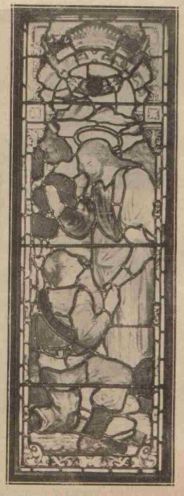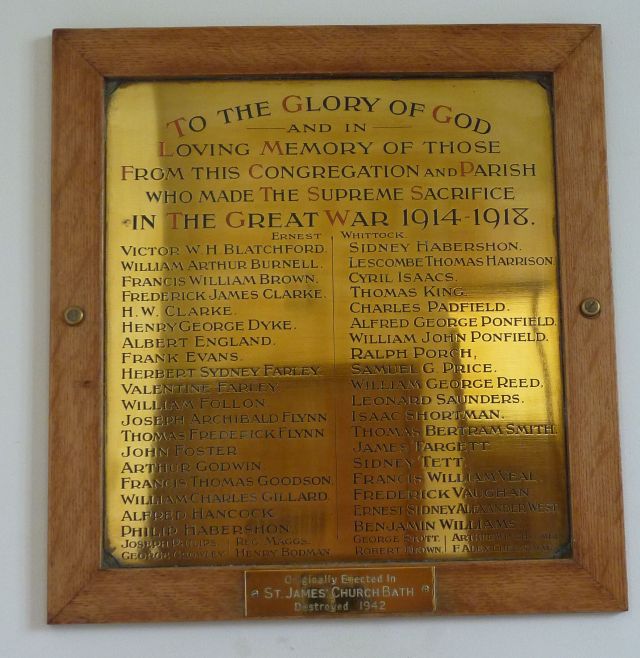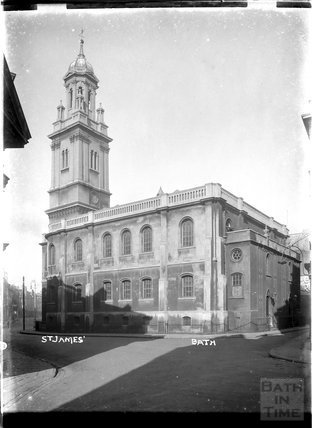In
January 1920, a line appeared in the newspaper to the effect that the
St James War Memorial Committee was preparing a plan to erect a stone
cross as a memorial in the grounds adjoining the Memorial Hall (now unoficially called 'Pigeon Park'). But this clearly did not materialise.
From the Bath Chronicle & Weekly Gazette, Saturday 6th March 1920:
"The
committee appointed to consider the character of the St. James's war
memorial met recently, and decided to recommend the erection in the
church of a commemorative tablet bearing the names of the fallen
parishioners and members of the congregation. It is suggested that the
total cost of the memorial shall not exceed £100. The committee have
under consideration several supplementary schemes which it is hoped
will add to the beauty of the interior of St. James's. "
From the Bath Chronicle & Weekly Gazette, Saturday 29th October 1921:
ST. JAMES'S, BATH.
WAR MEMORIALS DEDICATED.
COMMEMORATIVE WINDOWS AND TABLETS.
VISIT OF THE REV. R. W. B. MOORE.
By
their presence in large numbers at the service of dedication of their
parochial war memorials on Wednesday evening, the congregation of St.
James's, Bath, proved conclusively that they are still mindful of our
gallant dead. Forty-six parishioners or members the congregation are
commemorated in these memorials, which consist of two symbolical
windows in the west porch, one on either side of the main entrance, and
two commemorative tablets. The larger tablet, which has been placed on
the outside of the west wall of the church below the south memorial
window, commemorates all the 46 men who perished. The other tablet, the
gift of an anonymous donor, commemorates the three choirmen who
perished. The cost of the memorials was approximately £13O, and the
whole of the sum necessary was raised before the work was taken in
hand. THE DEDICATION SERVICE.
The
dedication was performed by the Rev. R. W. B. Moore, now Rector of
Haddesley, Yorks, and for 14 years Vicar of St. James's. The other
robed clergy present were the Vicar, the Rev. F. Garfield Waterbury,
and the Rev. J. O. Evans, a former curate. The churchwardens, Messrs.
A. E. Rowse and H. H. Sprouting, bearing their wands of office, walked
in the procession, as did Messrs. A. B. Titley and E. A. Spear (their
predecessors in that office). The St. James's Girl Guides, under Miss
Maud Spear, were present, and the St. James's Silver Band, conducted by
Mr. T. R. Thorne, took part in the service. Others in the congregation
who are practically interested in the work at St. James's were Mr. G.
E. A. Skinner (hon. lay reader), Mr. W. H. Smith and Alderman F. W.
Spear. Mr. H. C. T. Gill was at the organ. A
special form of shortened evensong was used. The processional hymn was
'O God, our help in ages past'. The special psalm was the 46th, "God is
our hope and strength", sung to Turner's chant in D flat. The Nunc
Dimittis was sung to the chant by Wallace in E. The service was
conducted by the Vicar, who also read the lesson, taken from the lesson
prescribed for use in the Burial Service. During
the singing of the hymn 'For all the saints', the choir proceeded to
the west end the church, the men leading. Here they halted in a double
line, and remained during the dedication ceremony. This was solemnly
performed the Rev. R. W. B. Moore, who recited the names inscribed on
the commemorative tablet. The choir then returned to their stalls at
the east end of the church, where the memorial to their three fellow
members who perished was, in like manner, unveiled and solemnly
dedicated. The anthem by Sir George Elvey, ' The souls of the righteous
are in the hand of God', with its memories of All Saints' Day, was
then sung. THE COMMENDATORY ADDRESS.
In
an address from the pulpit, based on Hebrews, ch. 11, verse 4, "He
being dead, yet speaketh", the Rev. R. W. B. Moore said their first
thought that evening was instinctively and inevitably of those gallant
members of their church whose names had just been read. Nobly they went
from their midst as did thousands of others throughout the land. As he
spoke that evening to his old friends in that church, and as they
recalled tbe hardships which their brothers had endured in the war,
they must feel that their minds were torn in two directions. On the one
side, they had their feelings of sorrow, on the other they felt the
value of that sympathetic link which had so long bound them together in
the parochial life of that church. The preacher, speaking from his own
store of intimate personal knowledge, then mentioned individually many
of those whose names appeared on that roll of honour, and
recalled many of their traits of character and the services they had
rendered to the life of the church. PARISHIONERS AND THE WAR.
Continuing,
he mentioned the service which the parishioners had rendered to their
fighting men during the war — works in which he and his family had been
privileged to take part. There had been the despatching of parcels and
subsequently the provision of a rest-room in that parish for invalid
soldiers. He had great pleasure in visiting his old parish again that
evening on the kind invitation of the Vicar. In their name, he
wished their Vicar God-speed, and prayed that he might granted
strength in the future. He understood that there was to be another
change in the life of that parish, and he desired to extend his
sympathy to the congregation in the trying time of transition. In the
name of tbe congregation, he would venture once more to bespeak their
sympathy for the coming Vicar, as he had done for his own successor.
The clergy, after all, were mortal and very fallible, and they should
not expect too much from their coming Vicar. He acknowledged the help
he had received during his own 14 years' ministry at St. James's from
hos two able churchwardens and from several other colleagues. But the
value of the spiritual work which had been accomplished in that parish
was really due to their predecessors. There was Mr cavill, whom, he
believed, few now remembered, the Rev. P. W. G. Filleul, and the late
Dr G. L. James, who died only a few months ago. The memory of the
sacrifice of their gallant dead, said the preacher, in conclusion, was
bound to have a posthumous influence. They seemed almost to hear those
voices beyond the veil. At
the conclusion of the sermon, the hymn 'On the Resurrection Morning'
was sung. Then Bugler Woolley sounded the "Last Post", which was
preceded by a roll of drums and accompanied by the band. After a pause,
the bugler sounded the glad notes of the "Reveille," and the solemn
service ended with the National Anthem, played by the band. THE WINDOWS AND TABLETS.
The
memorial windows are fixed in openings each side of the vestibule doors
and in the north panel a figure of Our Lord is shown extending His
blessing to a kneeling sailor. The south panel shows a soldier in khaki
surrendering his sword to Christ, symbolical that the fight is over and
victory won, while above the figures the "Crown of Reward" is placed.
The shafting and surrounding ornament is designed in harmony with the
general architecture of the church. The colouring is both rich and
effective, and considerably adds to the adornment of this church. The
inscription on the larger tablet is: "To the glory of God and in loving memory of those from this congregation and parish
who made the supreme sacrifice in the Great War, 1914-1918."
Victor
W. H. Blatchford, William Arthur Burnell, Francis William Brown,
Frederick James Clarke, H. W. Clarke, Henry George Dyke, Albert
England, Frank Evans, Herbert Sydney Farley, Valentine Farlev,. William
Follon, Joseph Archibald Flynn, Thomas Frederick Flynn, John Foster,
Arthur Godwin, Francis Thomas Goodson, William Charles Gillard, Alfred
Hancock, Philip Habershon, Joseph Phillips, Gorge Crowley, Reg. Maggs,
Henry Bodman, Sidney Habershon, Lescombe Thomas Harrison, Cyril Isaacs,
Thomas King, Charles Padfield, Alfred George Ponfield, William John
Ponfield, Ralph Porch, Samuel G. Price, William George Reed, Leonard
Saunders, Isaac Shortman, Thomas Bertram Smith, James Targett, Sidney
Tett, Francis William Veal, Frederick Vaughan, Ernest Sidnev Alexander
West, Benjamin Williams, George Stott, Robert Brown, Arthur Winchcombe,
F. Alex Cheeseman.
[N.B. The tablet today also includes the name of Ernest Whittock]The
inscription on the tablet on the north side of the chancel entrance, in
memory of the three choristers, who are also commemorated on the
general tablet, is: "To
the glory of God and in memory of Thomas Bertram Smith, Tom King,
Ernest S. A. West, choristers of this church killed in the Great War,
1914-1918." The
contractors for the entire work of the memorial windows and brasses
were Messrs J. W. Knight and Son, of 3 and 4, Beau Street, Bath.  One of the memorial windows as described in the newspaper article of 1921 One of the memorial windows as described in the newspaper article of 1921As
a footnote to the above, the 'trying time of transition' mentioned in
the address was occasioned by the resignation of one of the clergy, Rev
G. H. Curle, which was a 'difficult' episode for the parish as there
was a very public debate about the fact that Rev Curle was resigning on
grounds of his stipend being insufficient. |



